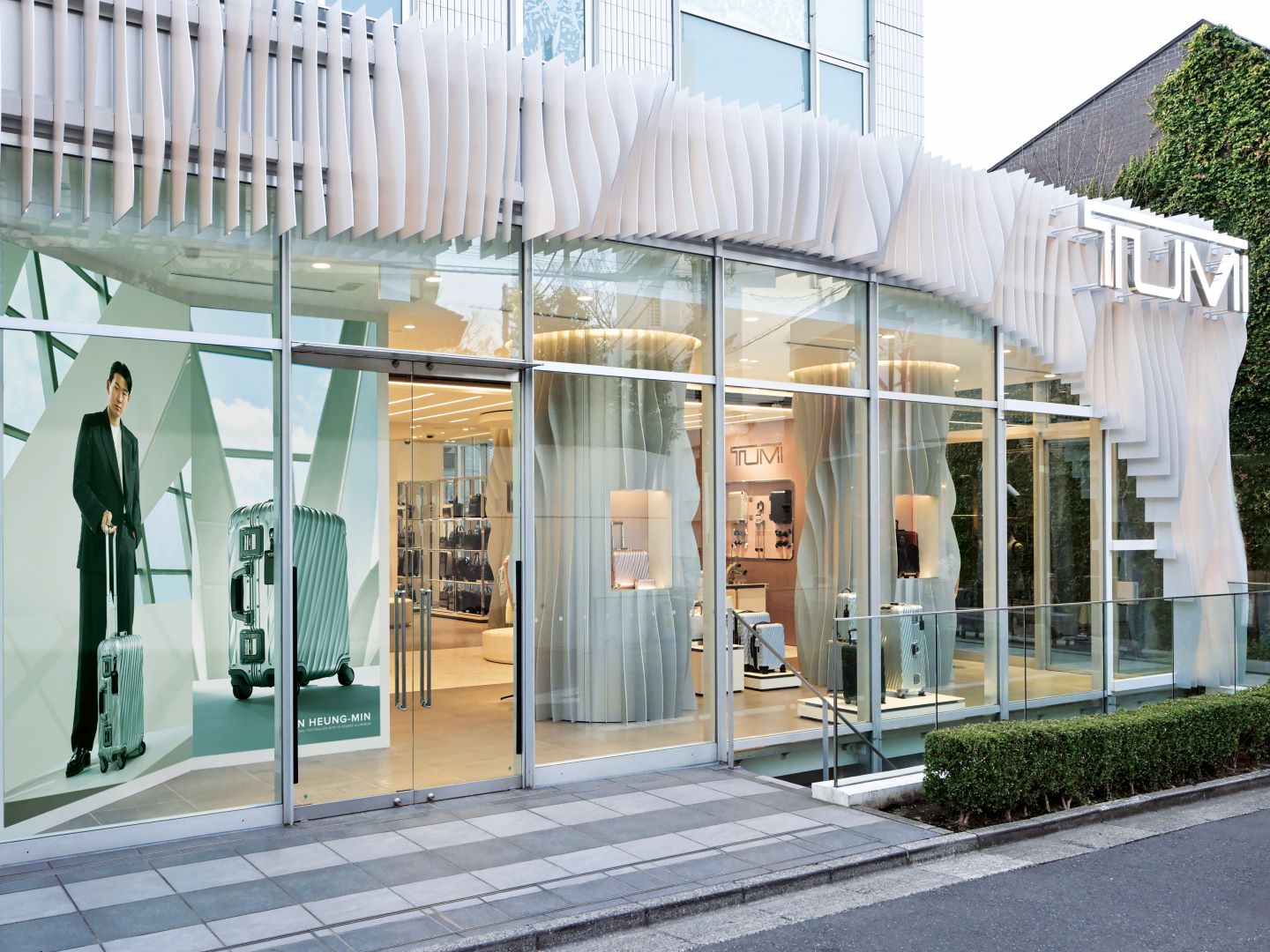
Over 250 aluminium ‘fins’ and LED lights lend the façade a three-dimensional effect (All photos: Tumi)
The biggest anxiety associated with flying, everybody knows, has little to do with bad airline food, turbulence or misrepresenting yourself to your seatmate as the most interesting person on the plane. The real panic usually occurs at the baggage carousel, where passengers firmly position themselves directly in front of the delivery chute, jostling to grab their bags as though it is their only chance. Will your suitcase come down the belt and, if it does, will it arrive unscathed?
Should you be worried, Victor Sanz, creative director of Tumi, has a piece of advice: “If your bag doesn’t have any scratches or stickers on it, you haven’t been anywhere at all.”
Spot a Tumi suitcase, whether at the airport or on the street, and it will look like it has a life that has been lived. Visible markings, dents, scuffs and all, demonstrate not only a test of time but also stories of journeys well travelled. Given Tumi’s price tag, no owner can be blamed for treating theirs like museum pieces, but these “functional, moving sculptures that can be retrofitted”, as Sanz calls them, are built to undergo natural wear and tear. Instantly identifiable by its durable hardware alone, while allowing opportunities for self-expression via bespoke monogramming, is the brand’s 19 Degree Aluminum collection.
Sculpted precisely at 19°, the signature contours of the beloved series have turned the suitcases fashioned from aircraft-grade aluminium into cool and contemporary icons. And nowhere are those attributes more fitting than inside Tumi’s new 2,000 sq ft home in fashion-forward Japan. Movement, airiness and elements that capture the quintessence of the discerning traveller have been transposed from bag to boutique at Tumi’s first Asia-Pacific flagship store in Tokyo’s Omotesando, a battleground for architectural one-upmanship as branded stores designed by branded names continue to populate this upscale retail epicentre.
kagami-biraki_ceremony_with_victor_sanz_creative_director_of_tumi_left_and_takumi_kitamura_japanese_actor_and_singer_take_me_1103_right_1.jpg
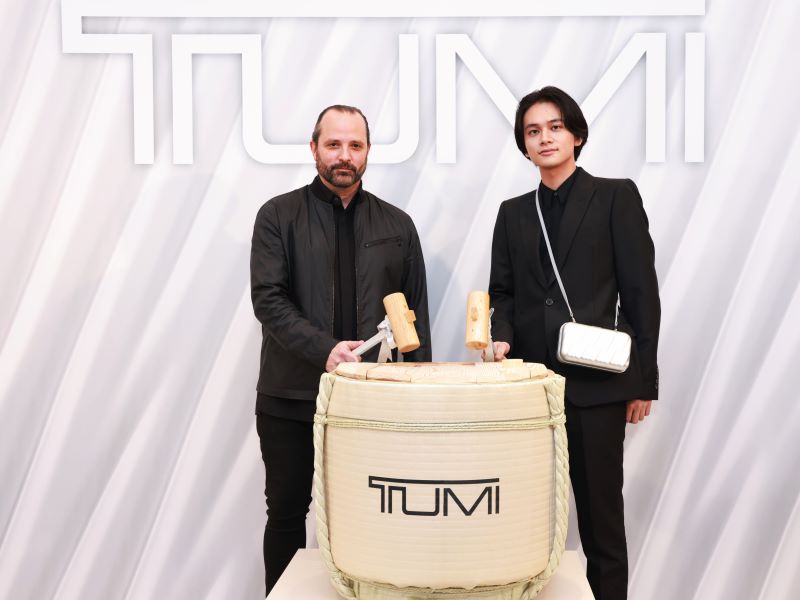
Modern bricks-and-mortar businesses have transformed both spatially and spiritually, now with amenities that dial down their pecuniary nature. At the very high end, they can span multiple nooks and functions, from the thematically curated window display to an intimate lounge that entices customers to try on the latest wares. This is also how the new Tumi store dialogues with its surroundings: Floor-to-ceiling glass doors admit life and light; pillars chiselled with an edge-curve cutting technique spark surprises when they lead to a concealed corner; pathways and multiple exits encourage perpetual flow in and out of the store.
“I just want my sculptures to find their way into people’s hands,” says Sanz, gesturing energetically with his wrist, like a conductor keeping a hurried tempo.
The Pratt Institute alumnus from New York wanted to become a sculptor after graduating at the top of his class but instead landed a job at the Eastman Kodak Company designing a new line of digital cameras. However, an “itch for fashion” prompted him to shift his gaze to Tumi in 2003. A long tenure there meant he was fortunate to work under CEO Charlie Clifford, who, in 1975, had co-founded the brand named after a Peruvian tumi ceremonial knife.
In the span of a few decades, suitcases have developed from receptacles for clothing into perambulating mobile homes. Tumi, which also caters for clients ranging from deejays to digital gamers, seems to have cultivated the knowledge and intuition to give customers what they did not know they needed.
“A bag is much more than the sum of its contents,” explains Sanz while revealing every hidden compartment and expandable pocket of an Alpha Bravo Esports Backpack like a party trick. “Travelling is about moving and we want to create something that captures that. For example, how does the pattern on the 19 Degree transform when you carry it? How do the curves catch the light? It is a three-dimensional world that should look the same when viewed from all sides.”
This 360° aesthetic was further fleshed out in the form of a sculpture hanging overhead in the Omotesando stronghold, anchoring an art gallery-inspired circular seating area and a towering digital display. Conceived with the expertise of perceptual art pioneer Michael Murphy, who shot to fame with a multi-layered portrait of former US president Barack Obama in 2007, the centrepiece gives the illusion of a 19 Degree Aluminum suitcase at first glance before shape-shifting into a ‘T’ logo as one circles it.
tumi_omotesando_store_tumi_19_degree_aluminum_sculpture_1_1.jpg
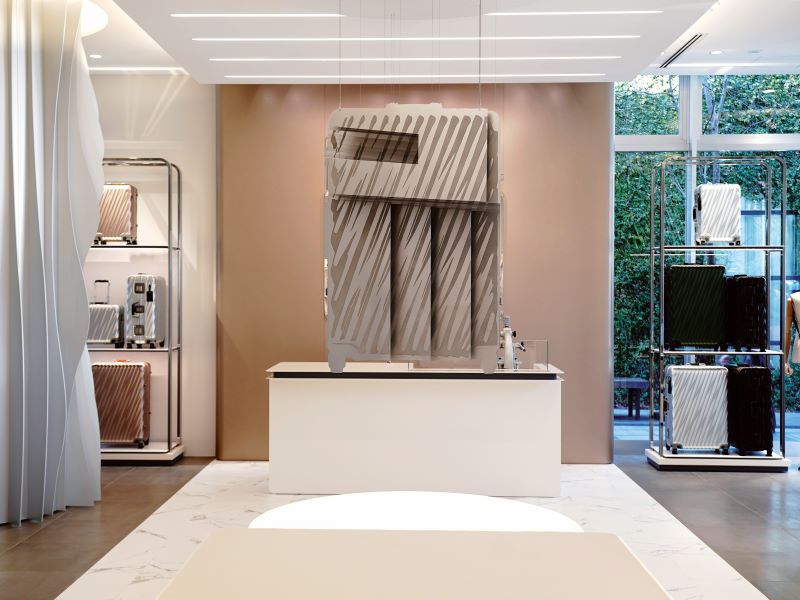
Similar to Tumi, Murphy is often after something more than the staging of objects. The intricacies and adrenaline of assembling a narrative have led to a collaboration that transcends creative disciplines.
“We are excited to work with Michael again after he created the Hypercraft Sculpture for our Fall 2023 collection pop-up in South Korea, where pro footballer and Tumi Crew member Son Heung-min also attended. How do you bring clarity and order to a group of seemingly disorganised suspended elements? How do you create a showstopper that blends in with your brand DNA and helps transition your shopping experience without upstaging the products? We spent so much time in the studio exploring possibilities and [labouring over the] details. Bouncing ideas off each other kept us going,” asserts Sanz, who introduces novel interpretations by partnering industry leaders such as racing automotive giant McLaren, esports stalwart Razer, and Italian luxury fashion house Missoni.
“I told Angela [Missoni], ‘Wow, you are very technical with your knits.’”
Artistry and technique are also especially interwoven with a dichotomous Japan where it still juggles between the proliferation of technology and the preservation of tea houses. But no matter the genre or profession, attention to detail remains a steadfast tenet and fundamental quality that underscores every craftsmanship.
Sanz takes care to explain the difference in sensibility between Tumi’s customers in Asia and their western counterparts. “The Japanese are our strongest critics, and this is also why we look to them constantly for improvement and innovation. They see a feature, like the thickness or shape of an aluminium, interact with it and understand how it is going to mean to them. Nothing is superfluous and they hold details in the highest regard.”
Brands continue to widen their lens on Asian identity as expressive dressing prevails over prescribed style, particularly in this part of the world. The younger generation demands elaborate technical explanations of how a certain clasp, handle, contraption or fabric work, not because they are less shrewd but because they have greater curiosity.
“Tumi, as most of you know, started with designs that appeal to business elites and serious jet-setters. But we’ve moved on to shades and motifs to ensure we’re speaking to all customers and not a single entity. Our demography is shifting as we are also catering to different age groups and hobbies,” says the art-loving Sanz, who crowds his sketchbook with musings, be it from a shadow play between buildings or a pattern on the sidewalk, and takes it everywhere in his (current) favourite Alpha Bravo Navigation Backpack.
tumi_omotesando_store_interior_2_1.jpg
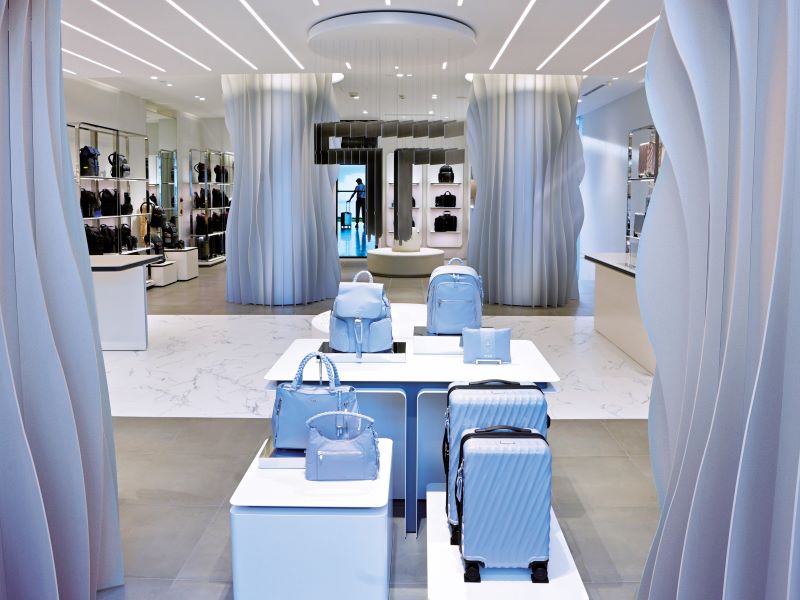
Anyone who still thinks Tumi is playing it safe has not been paying attention. Colours have made a merry appearance in the brand’s Singapore-inspired Spring 2024 collection, which, propped next to a shelf of monochromatic cases, appears like fireworks against a night sky. Vivacious hues such as acid green, halogen blue, purple and a summery palette evocative of Sentosa Island during sunset proved that imagination is not inhibited by geographical boundaries in this visual era. Energised and primed for the everyday, these pieces — including a special selection for golfers — are ready to play.
Travellers can find a few products exclusive to the Omotesando store, but the 19 Degree Titanium Briefcase — only available in select outlets including its Japanese address — will always be a talking point. An innovative addition to the ensemble, the titanium construction boasts superior strength, yet it is smooth to the touch as an adjustable shoulder strap with quick-release button and a retractable carry handle in leather soften its build. The metal is not easily commanded, which poses a fresh thrill for the team at Tumi, who enjoy experimenting with difficult materials and dealing with their challenges.
“It was as if we’re relearning how to make the pieces!” admits Sanz. “The tools to work with titanium are different so we sought other experts to develop our own. But the process does not stop at just forging a case. What about the technology, convenience and functionality? Even something as mundane as a shoulder strap attachment should be an experience for customers to play around with. We’re obsessive about our designs but we’re obsessive with a purpose,” claims Sanz.
His tenacity and eagerness — both professional and personal — can be traced, in part, to the role model in his life. “My father [whose hometown is in Cascajares, Spain] was a chef and he loved creating meals for people and seeing their happy faces when they ate. I think that resonated with me too. When I see people using the products I make and their lives feel more fulfilled, I get the same satisfaction. But, as most fathers do, he also told me he never understood some of my designs. It’s like, ‘I support you but I don’t get this’. That’s probably a good thing because it means my work got people thinking.”
tumi_19_degree_bus_image_1_1.jpg
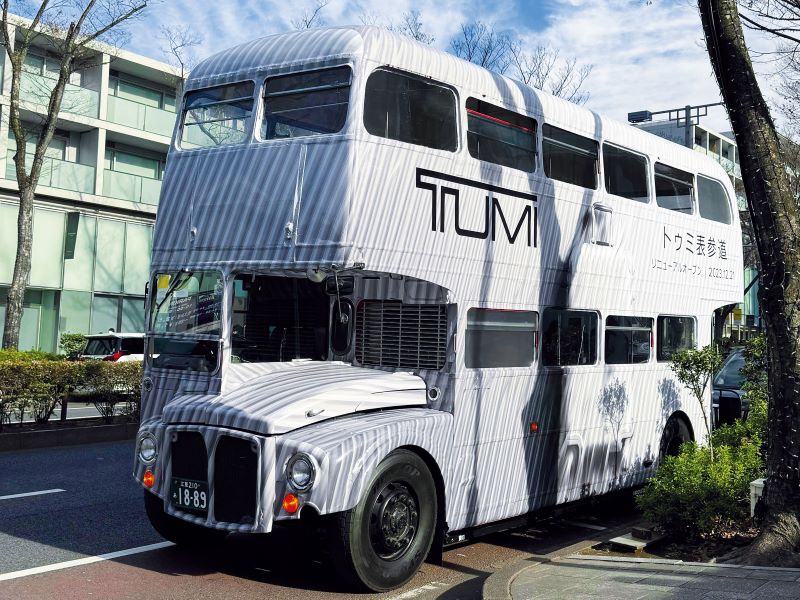
Like fashion, what you wear or carry when you are seeing the world is no longer dictated by a cabal of design arbiters — the acknowledgement that not all people look the same has led to the epiphany that not everyone wants to dress similarly. Tumi’s provocation to the establishment is to eschew uniformity and inculcate a certain personality. That is also the reason we were shuttled from the Omotesando store to an elaborate dinner aboard a yakatabune (restaurant on a traditional Japanese cruise boat) along the Sumida River complete with a geisha performance in an eye-catching, custom-wrapped 19 Degree bus. It’s all about motion (and genius marketing), remember?
The official store opening, graced by prominent faces such as American ice-skating Olympian Alex Shibutani, rock guitarist Miyavi Lee Ishihara and Thai actor “Blue” Pongtiwat Tangwancharoen, was no less a spectacle. Sanz as well as Japanese actor Takumi Kitamura of Tokyo Revengers and YuYu Hakusho fame led the kagami biraki, or saké barrel-breaking ceremony, in lieu of the typical ribbon-cutting, to mark new beginnings and usher in prosperity. The rice wine, poured into a square wooden masu, was served to guests as a means of sharing good fortune and success.
Success, however, is not always a fortuitous circumstance. To remain relevant, Tumi will need to observe how people take to the road, rails and skies, and evolve in a way that still taps into the romance long associated with travel.
Packing for an adventure makes our hearts leap at the possibility of what a journey can hold. A trusty bag unleashes that freedom but keeps the memories.
BAGGING RIGHTS
Top picks for the frequent flyer who values fashion and function
tumi_bags.jpg
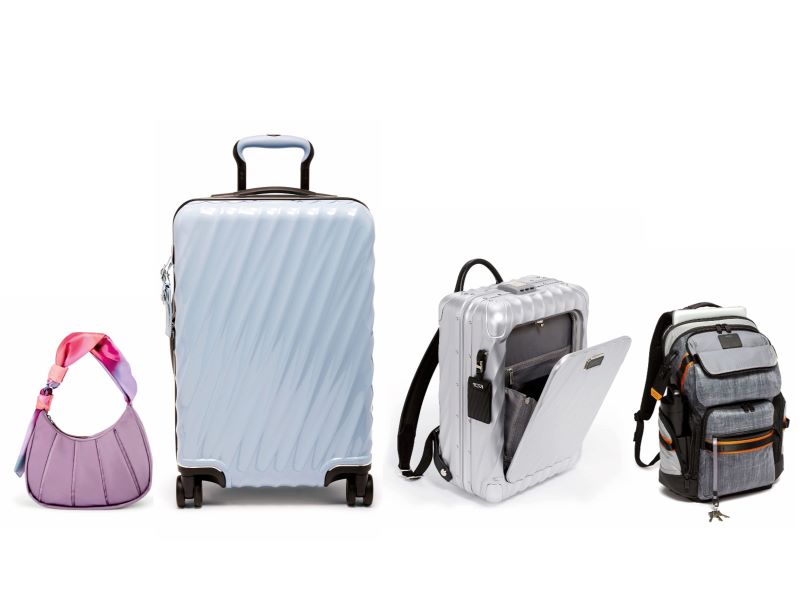
Asra Shoulder Bag
Instead of digging through a seemingly bottomless handbag to fi nd your belongings, the Asra in purple and sunset shades is fi tted with nifty compartments to pocket a smartphone, keys or lipstick for a last-minute make-up emergency. (RM2,190)
19 Degree International Expandable 4-Wheeled Carry-On
Forget Pantone’s Colour of the Year, Halogen Blue is the new peach fuzz. Glide seamlessly from door to destination with this lightweight luggage made with a recycled polycarbonate shell. (RM3,850)
19 Degree Aluminum Backpack
The first of its kind for Tumi, the bag with a push-open latch off ers the convenience of a well-organised mini closet. You won’t even notice the wheels are missing. (RM8,960)
Alpha Bravo Nomadic Backpack
It’s all in the name. This rugged option in steel colour is crafted with high-performance weather-resistant fabric to withstand whatever Mother Nature throws at you. A huge capacity means your gear is properly secured so you only have to focus on the road ahead. (RM4,480)
See Tumi’s Spring 2024 collection at its newly opened flagship store in The Exchange TRX, Kuala Lumpur or visit tumi.my
This article first appeared on Jan 22, 2024 in The Edge Malaysia.


